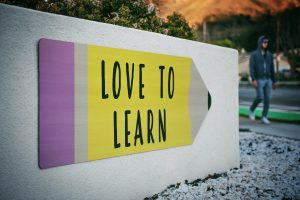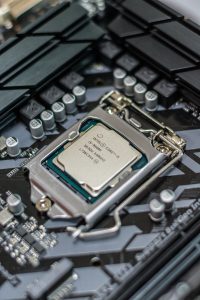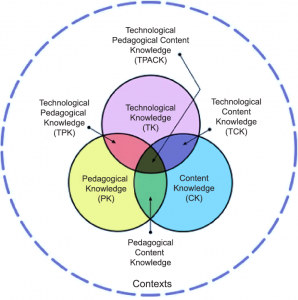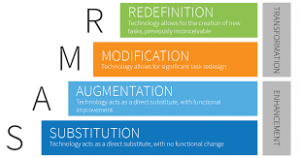
Photo by Tim Mossholder
My following blog consists of an annotation on Mapping Research Trends from 35 Years of Public Education in Distance Education, including a brief explanation of the themes discussed in the article, followed by my critical reflection, based on the What? So What? & Now What? framework.
Introduction:
Zawacki-Richter’s and Naidu’s article provided insight into the evolving themes highlighted within the journal, Distance Education, over the time-frame of thirty-five years. The authors use of the Leximancer, a “text-mining tool…used to identify and describe themes in distance education” (p. 245, 2016) over the period 1980 to 2014, provided insight into specific themes commonly researched, throughout the given time frame. Common topics included “professionalization and institutional consolidation, instructional design and educational technology, quality assurance, student support, collaborative learning and interaction, virtual learning, and the integration of MOOCs (Massive Online Open Courses) and OERs (Open Education Resources)” (p. 245, 2016).
Theme #1: Professionalism & Institutional Consolidation
The first theme, professionalism and institutional consolidation between 1980-1984, identified in the article, involved researchers focusing on the establishment of a common language and scholarship within distance education itself. The article suggested that, although many distance education institutions had already been developed by this time, researchers in the early 1980’s identified this period as a “time of reflection” (p. 251) whereby, distance education institutions and educators alike, focussed on establishing recognition of being both scholarly and professional.
Theme #2: Instructional Design & Education Technology
Instructional design, and educational technology, was the second evolving theme, common among distance education researchers and writers during 1985-1989. The focus, at this time, was on the significance of course design, concerning its impact on scholarly content and course delivery within the realm of distance education, in addition to the opportunity and supportive elements technology provided to learners. Zawacki-Richter and Naidu indicated that the use of technology became recognized as a method to bridge the distance between learners, educators and institutions alike.
Theme #3: Assurance
Quality assurance in distance education developed, between 1990 -1994, as the third theme, common among researchers. During this period, two main focal points within distance education were commonly discussed. The first, included the provision and/or improvement upon quality education, while the second, involved different ways to present information and provide improved access to learners. Zawacki-Richter and Naidu noted that this was a period of time where researchers recognized the significance of utilizing technological developments, including “remote audio and video conferencing systems” (p. 253) to assist in learning, and to provide enhancements to the traditional “paper based study materials” (p. 254).
Theme #4: Student Support & Online Learning
Between 1995-1999, the fourth theme focused on student support and online learning. During the late 90’s, the goal within distance education, was to provide improved support for distance education learners. During this time, students’ learning, support, instructional design, and learning materials became increasingly interconnected, resulting from the growth and implementation of education technology. The use of the internet and new communication technologies provided and supported more access to information to the growing population of distance learners, regardless of their geographical location. Additionally, educational technology tools, provided growing opportunities to share resources and facilitate collaboration processes among learners, educators and institutions alike.
Theme #5: Virtual Learning in Distance Education
The fifth theme, commonly discussed between 200-2004, was virtual learning. The aforementioned article, indicated that the growth of information technology, clearly challenged the traditional education setting. New technology enabled both educators and learners to teach and learn, respectively, from virtually anywhere in the world. The possibilities that technology afforded distance learning were immense. However, it also brought forth new and unforeseen challenges, including, but not limited to, privacy issues, participation difficulties and ethics. These new domains would certainly be explored, henceforth.
Theme #6: Collaborative Learning & Online Interaction
Research in distance education, during 2000-2009 focused more heavily on collaboration and the growth of online interaction. Online education provided learners the opportunity to engage in courses that adopted a variety of technology tools, teaching methodologies and learning processes. Studies focused on both asynchronous and synchronous learning styles, and the effects of collaboration on the learning process. The rise of new technologies and teaching methods in distance education afford both growing opportunities and support to institutions, educators, and learners.
Theme #7: Interactive Learning, MOOCs and OERs
Research from 2010-2014 focused on the technology that facilitated in providing accessibility and thus equity, thereby enabling interaction between both educators and students, from basically anywhere in the world. Furthermore, this new technology led to the growth of MOOCs and OERs, which in turn, led to further development of new courses, educational flexibility, growing knowledge and connectivity on behalf of the instructors and learners.
Article Critical Reflection: Following the What? So What? Now What? Framework
Photo by Nikita Kachanovsky

What?
The Zawacki-Richter and Naidu article provided me, the learner, with an understanding of specific, distance education trends that were commonly researched between 1980-2014. The chronological format and use of diagrams provided detailed information outlining the growth, developments and changes technology tools advanced in the world of distance education. Prior to reading this article, I never really considered the profound changes and intricacies that were involved in both the development and exponential growth of distance education, and in turn the outcomes and new challenges that evolved with this new style of learning, yet I have seen the value in the opportunities of distance education, both for myself, as a current distance education student, and the students within our school or district.
The district I currently work for, operates a distance learning school, separate from the traditional brick and mortar traditional settings. E-Bus, as it is called, enrolls thousands of students across B.C., including full time students and cross-enrolled students. This distance education school, enables students to take courses that may not fit into their regular time table schedule, take courses not offered in their school, and/or take extra courses based enabling them to work ahead. Regardless of the reason as to why students enroll, it is important to recognize the options and opportunities that distance education can provide.
So What?
The advancements of distance education is important to consider, as it impacts various elements, including, but not limited to educational opportunities, growth of scholarship, institutional course loads and availability, need for more educators, economics to fund more courses and pay more educators, flexibility in the areas of teaching and learning, increased access to learning and teaching opportunities, thus increasing education equity, to those involved.
From a personal and professional perspective, having the opportunity to complete my masters degree following a distance learning format enables me to further my education, while staying in my home community where I can be with my family and maintain working at my career as a teacher. Without this opportunity, it would be difficult, if not impossible for me, at this time, to complete this professional, educational adventure. Therefore, I am grateful to follow an online, distance education configuration. Furthermore, my distance education experience is providing me with the opportunity to meet, listen to, learn from and collaborate with peers and educators from around the province, country or world, which in turn provides a wealth of knowledge and experience, from which to learn.
Now What?
Personally, I would recommend taking an online, or distance education course/program, to anyone considering it, if the opportunity is available and it suits their needs. The flexibility and opportunities provided are positive characteristics to consider, especially if you live in remote areas, are not able to simply uproot and move closer to a post-secondary institution, and/or have a career commitment.
Professionally, distance education courses are providing me with the opportunity to improve upon my teaching, reflecting, and communication skills, which will positively affect my students learning experiences. As a Career Teacher and Career Coordinator, I would not hesitate to discuss my distance education experience with my students, as it demonstrates, that learning is a life-long process. Furthermore, discussing distance education options, may provide students with other learning possibilities as they move on to post-secondary learning environments, or work and study part time.
Thus far, I have found the opportunities provided by online distance education, to be a positive, growing experience. It is forcing me to become a “speaker” in the group, rather than a bystander. I am enjoying this new process, and again, grateful for it!
Photo by Matthew Sleeper
Written By: Deirdre Houghton

 Conclusion:
Conclusion: 

 INTRODUCTION:
INTRODUCTION:


 WHAT:
WHAT: WHAT?
WHAT? 




